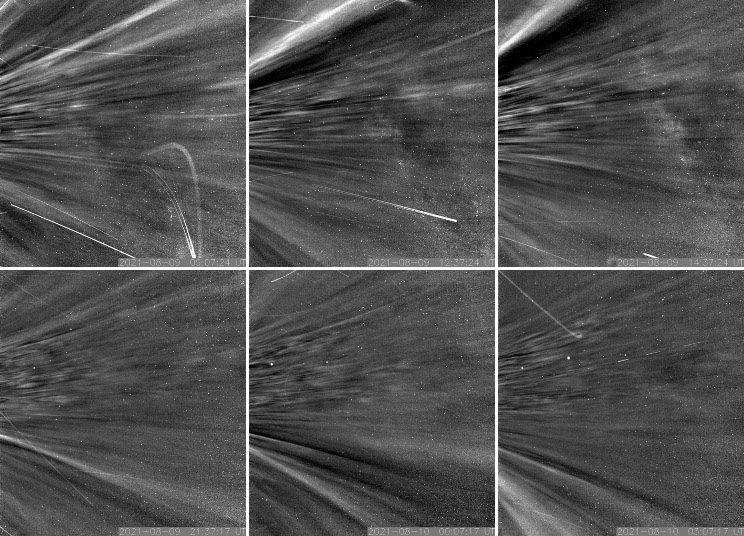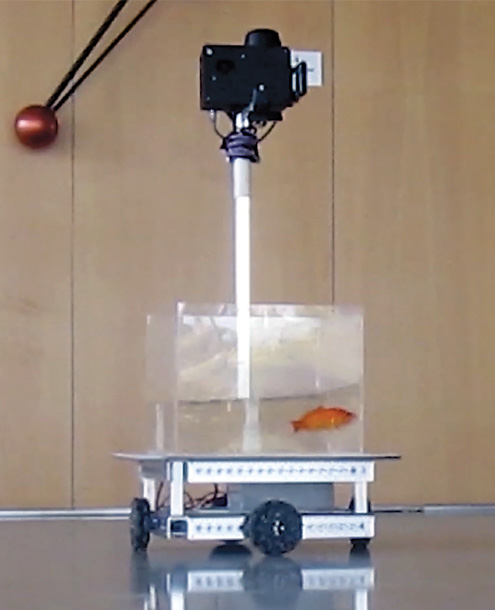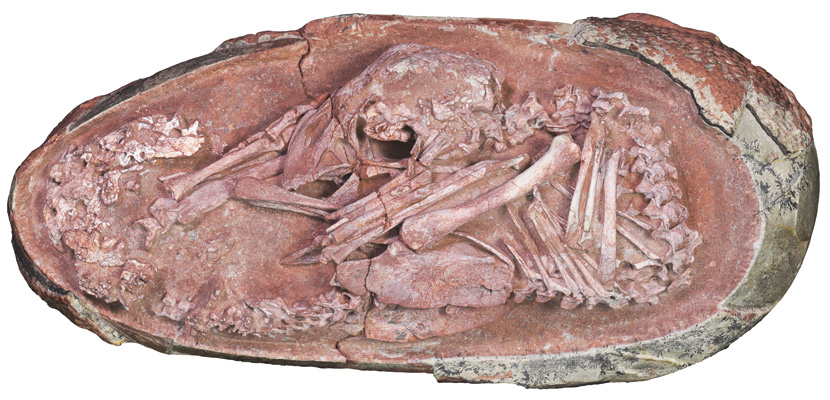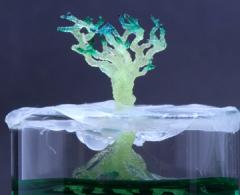
This Article From Issue
March-April 2022
Volume 110, Number 2
Page 77
In this roundup, managing editor Stacey Lutkoski summarizes notable recent developments in scientific research, selected from reports compiled in the free electronic newsletter Sigma Xi SmartBrief.
Stellar Encounter

NASA/Johns Hopkins APL/Naval Research Laboratory
The Parker Solar Probe has made contact with the Sun’s corona, which marks the first time that a spacecraft has touched a star. The probe spent five hours below the Alfvén critical surface, the point where the magnetically dominated solar atmosphere ends and solar winds begin. Before this foray into the corona, heliophysicists could only estimate the location of that boundary. Based on its measurements of solar particles and magnetic fields, the spacecraft crossed the barrier approximately 13 million kilometers from the Sun’s surface. It then passed in and out of the corona several times, which indicates that the Alfvén critical surface has dips and spikes. The spacecraft also captured images of pseudostreamers (above), the coronal streaks visible during solar eclipses. The Parker Solar Probe, named after astrophysicist Eugene Parker, launched in 2018. (See “Parker, Meet Parker,” November–December 2018.) It will continue in a spiral orbit around the Sun, getting closer and closer to the surface, until 2025, with an expected final approach about 6.2 million kilometers from the surface.
Kasper, J. C., et al. Parker Solar Probe enters the magnetically dominated solar corona. Physical Review Letters 127:255101 (December 14, 2021).
Fish Take to the Road

Ben-Gurion University of the Negev
Goldfish may not be licensed to drive, but they are zipping around in a specially made vehicle. Biologist Shachar Givon of Ben-Gurion University of the Negev in Israel wanted to know more about how fish navigate, so she teamed up with biomedical engineering and computer science colleagues to create a fish-operated vehicle. They placed a goldfish inside a square tank onto a chassis with four multidirectional wheels. A downward-facing camera captured the direction in which the fish was swimming, and an algorithm prompted the vehicle’s wheels to move in the same direction. The researchers then used treats to train the goldfish to reach visual targets in the terrestrial world. The six goldfish in the experiment navigated around obstacles, avoided dead ends, and became progressively more proficient at reaching their goals. The results demonstrate that navigational abilities may not be specific to an animal’s native environment. In addition to broadening our understanding of animal navigation, the study may help humans move through unfamiliar environments, such as zero gravity.
Givon, S., M. Samina, O. Ben-Shahar, and R. Segev. From fish out of water to new insights on navigation mechanisms in animals. Behavioural Brain Research 419:113711 (February 15).
Durable Bubbles
Physicists have made a long-lasting version of the quintessentially ephemeral soap bubble. The same properties that make bubbles fun to blow and chase are also responsible for their fragility: Their thin, liquid skins quickly succumb to evaporation, gravity-induced drainage, and environmental hazards, resulting in a satisfying burst. A team of French physicists made a stronger bubble by incorporating glycerol into the soap mixture and covering the bubble in a shell of microparticles. The resulting gas marble retains the liquid shell that is characteristic of a bubble, but is hardier. Glycerol absorbed water molecules from the air, counteracting evaporation, and the microparticles inhibited drainage, resulting in a bubble that maintained its structural integrity for more than a year. (It popped on day 465, possibly because microbes were growing on its surface—the bubble had begun to turn green prior to the rupture.) To shape the bubble, the physicists spread a granular jammed layer of polyamide-11 (a nylon polymer) particles on the surface of the water-glycerol solution. (See “Designed for Change,” September–October 2021 for more information on granular jamming.) They then used a syringe to inject air below the raft, creating a 5.1-millimeter-radius bubble. Using a spoon, they rolled the orb to cover it in the polymer particles, and then lifted it out of the water and onto a hydrophobic surface. In addition to blowing bubbles, the researchers also covered a metallic, pyramid-shaped frame with the polymer film, resulting in a liquid layer that also lasted for more than one year (378 days and counting at the time they published their article). The success of the pyramid suggests that the granular-jammed skin could be used to form other fluidic objects with novel physical and chemical properties.
Roux, A., A. Duchesne, and M. Baudoin. Everlasting bubbles and liquid films resisting drainage, evaporation, and nuclei-induced bursting. Physical Review Fluids 7:L011601 (January 18).
Dinosaur Development

Xing, L., et al.
An exceptionally well-preserved oviraptorosaur egg shows the embryo curled in a position reminiscent of that of a modern bird embryo. This finding indicates that the nonavian theropod may have had hatching behaviors similar to those of birds and distinct from those of crocodilians. If that is the case, then the avian hatching behaviors may have deeper roots than previously thought. The Late Cretaceous fossilized egg measures 16.7 centimeters by 7.6 centimeters. The skeleton is curved, with the skull directed toward the pointed end of the egg and the spine curled against the opposite side—the same posture as embryonic birds during the pretucking stage. The fossilized egg was found in southern China and is among the most complete nonavian dinosaur embryos yet discovered.
Xing, L., K. Niu, W. Ma, D. K. Zelenitsky, T.-R. Yang, and S. L. Brusatte. An exquisitely preserved in-ovo theropod dinosaur embryo sheds light on avian-like prehatching postures. iScience doi:10.1016/j.isci.2021.103516 (December 21, 2021).

American Scientist Comments and Discussion
To discuss our articles or comment on them, please share them and tag American Scientist on social media platforms. Here are links to our profiles on Twitter, Facebook, and LinkedIn.
If we re-share your post, we will moderate comments/discussion following our comments policy.